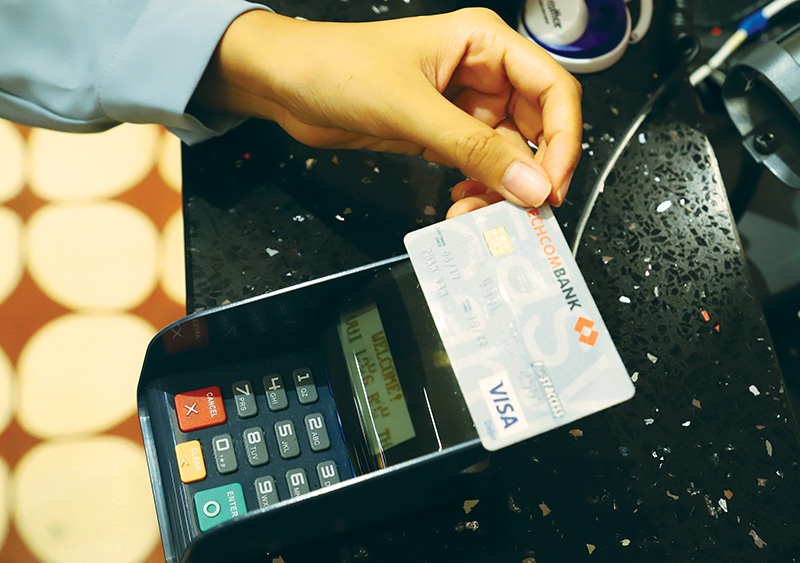Banks reposition for trend transition
 |
| There are more and more options for customers instead of just using cash, Photo: Le Toan |
National Payment Corporation of Vietnam (Napas) inked a comprehensive agreement in mid-November with a group of 13 lenders to facilitate their financial services with a domestic credit card, including Vietcombank, Vietinbank, BIDV, Agribank, Techcombank, and more.
The increased payment acceptance network is complemented by various communication initiatives aimed at disseminating information and skills in order to instil the habit of using card payment on a regular basis.
Domestic credit cards, according to Nguyen Hoang Long, deputy general director of Napas, boast potential for growth and provide numerous benefits to clients, helping the promotion of the non-cash payment trend and eradicating black credit.
The Vietnamese government in October approved Decision No.1813/QD-TTg regarding the development of non-cash payments in Vietnam towards 2025, in which the non-cash payment value would be 25 times higher than GDP.
According to a recent study by Vietnam Banks Association (VBA), the total number of cards issued and in circulation in the country as of June 30, 2021 reached 110 million of all types, up 28 per cent from the end of 2018. Domestic cards accounted for 90.4 million, or around 82 per cent.
In terms of the number of cards in circulation, the four biggest banks are VietinBank with 16.9 million cards (15 per cent); BIDV with 15.3 million (14 per cent); Vietcombank at 15.1 million (14 per cent); and MB with 7.6 million cards, accounting for 7 per cent.
In terms of domestic debit cards, the total number of cards in circulation reached 85.7 million. Notably, the top five banks of VietinBank, Agribank, BIDV, Vietcombank, and DongA Bank make up for the majority of the market share.
Sales of all types of member organisations’ cards climbed by 24 per cent on-year, and domestic debit card sales rose by an average of 8 per cent annually. Vietcombank maintained its lead in domestic debit card sales, with a 23 per cent of market share, followed by Agribank (19 per cent), and BIDV (13 per cent).
However, as a result of the pandemic, people’s spending and shopping demands fell, resulting in an 11 per cent fall in domestic card sales since 2020. In 2021, the proportion of cash withdrawal via card has gradually decreased from 85 per cent in 2018 to 78 per cent by June 30.
Privately-run banks such as Techcombank and Sacombank dominate the international card segment in Vietnam. According to the VBA, sales of overseas debit cards climbed by 27 per cent annually from 2018 to 2020; as of June 30, 2021, sales had reached $10.68 billion, a 41 per cent rise over the same time. The top five banks in terms of market share are Sacombank (32 per cent), Techcombank (18 per cent), VietinBank (10 per cent), ACB (9 per cent), and Vietcombank (8 per cent).
International credit card sales surged dramatically between 2018 and 2020, at a rate of 33 per cent annually. International credit card sales climbed by 32 per cent on-year as of June 30, 2021, hitting $9.55 billion. TPBank (17 per cent), VPBank (16 per cent), Techcombank (15.7 per cent), VIB (8 per cent), and Sacombank (6 per cent) are the top five major banks in terms of market share.
As concerns foreign card payment sales by VBA members, the first six months of 2021 saw a 55 per cent rise over the same period last year, reaching $20.65 billion, while the average growth rate for the period 2018-2021 was only 19 per cent annually.
A wide range of payment methods, stated Nguyen Minh Tam, deputy CEO at Sacombank, has laid a concrete foundation for non-cash development for cards, e-wallets, mobile money, and QR codes, among others.
“Cards still play a significant role in cashless payment but this category has undergone modifications, such as a transition from magnetic card to chipped card, QR codes, and contactless card,” Tam said.
What the stars mean:
★ Poor ★ ★ Promising ★★★ Good ★★★★ Very good ★★★★★ Exceptional
Related Contents
Latest News
More News
- Securing capital and efficiency for Vietnam’s 2026-2030 growth ambitions (December 17, 2025 | 10:00)
- Energy sector in need of blended finance mechanisms (December 17, 2025 | 09:00)
- Vietnam still has room to mobilise capital for sustainable growth (December 17, 2025 | 08:57)
- Long-term capital seen as key hurdle to green growth (December 16, 2025 | 08:00)
- Gold prices swing amid tax debate and import uncertainty (December 15, 2025 | 18:04)
- Agribank frames bank credit as catalyst for green growth (December 15, 2025 | 17:59)
- Vietnam’s green transition demands collective financial action (December 15, 2025 | 12:00)
- VIR workshop highlights capital and policy for sustainable development (December 15, 2025 | 11:00)
- Promoting digital assets initiative in Vietnam (December 13, 2025 | 09:30)
- Experts flag gaps as national financial strategy under review (December 12, 2025 | 15:13)

 Tag:
Tag:






















 Mobile Version
Mobile Version